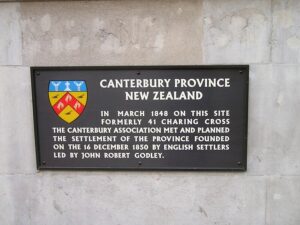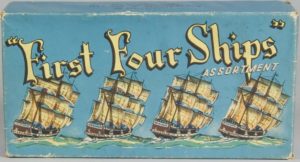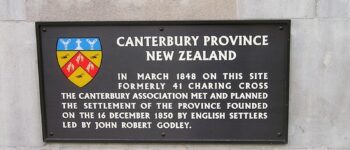1848: The Canterbury Association
March 28, 2024
By AHNZ

Today in history, 28 March, 1848 The Canterbury Association met for the first time. This was at 41 Charing Cross, London, and the local time was 27 March which is how most sources record the time but AHNZ prefers to record dates using New Zealand’s calendar.
To us, especially Cantabrians, names like Cavendish, Charterius, Coleridge, Courtenay, Cust, Halswell, Heathcote, Lyttleton, Sumner, Torlesse, and others are places we live and work. In 1848 they were the names of men with a plan.
They clearly weren’t there to excite arachnids.¹
By 12 June of the same year The Kemp Deed was signed at Akaroa with 40 leading Maoris and the lands we know as Canterbury purchased. Ref. 1848: The Kemp Deed, AHNZ
By 6 July Captain Joseph Thomas and surveyors Thomas Cass and Charles Torlesse were on their way to New Zealand. Having shaken hands with George and George (Governor George Grey and Bishop of New Zealand George Selwyn) and getting their blessing, Thomas accessed the timely and convenient help of the steamship HMS Acheron that happened to be going his way. Ref. 1848: The Acheron Survey, AHNZ
The team arrived on 15 March, 1849, at Port Cooper (soon to be called Port Lyttelton) and inspected the land Kemp and Walter Mantell had purchased and acquired it for the Canterbury Association. They started getting the place tidied up for the first settlers. Meanwhile, back in Britain, the Canterbury Settlement Land Act was passed into law on 14 August, 1850. This defined the Canterbury Association territory and its arrangement with the New Zealand Company.

The First Four Ships of Canterbury Pilgrims arrived from 16 December, 1850. Ref. 1850: Pilgrims Landing, AHNZ
A very impressive burst of energy in just under 3 years. Contrast this with the 2020s where it is controversial for Resources Minister Shane Jones to say “if there is a mineral, if there is a mining opportunity and it’s impeded by a blind frog, goodbye, Freddie.” Or, where sailing races on Lyttleton harbour must be called off because dolphins were seen in the sea. Ref. Newsroom (March 2024)
Cantabrians are not descended from fearful men concerned primarily with spiders, dolphins, and frogs. Those who are can only afford to be because of the energy, risk-taking, and wealth-creation of those who make man the measure of all things. It must take something like 100 people with their feet on the ground to pay for every misanthrope with his head in the clouds.
“The time seemed ripe for s mh. an undertaking. A wave of revolutionary feeling and of social disturbance was then passing over Europe. “The future was dark and troubled. Mens hearts were failing them for fear.” – Canterbury Papers I, The Foundation of the Canterbury Settlement, Josephy Wilson, Canterbury College (1914)
“The Canterbury Association has done its work, and passed away. Its memory may be unhonoured, its members reviled; they care not; they have done their work—a great and heroic work: they have raised to themselves a noble monument—they have laid the foundations of a great and happy people.” – Speech of John Godley upon returning to England from Canterbury, 1853
“…Canterbury Association (1848 – 1853) with the aspirations of building an Anglican city around a Cathedral and a college somewhere in New Zealand. There would be eighty four members eventually – a collection of upper class families, peers, clergy, politicians, military, work and college buddies whose names are mostly remembered in the naming of Canterbury’s towns, suburbs, rivers, mountains and lakes.” – DISCO
“1848, the year that saw Europe engulfed in revolution. Across the continent, from Paris to Palermo, liberals rose against conservative governments. The first stirrings of rebellion came in January, in Sicily; in February the French monarchy fell; and within a few months Germany, Austria, Hungary and Italy had all been overtaken by revolutionary fervour. Only a few countries, notably Britain and Russia, were spared.The rebels were fighting for nationalism, social justice and civil rights, and were prepared to fight in the streets down to the last man. Tens of thousands of people lost their lives; but little of lasting value was achieved, and by the end of the year the liberal revolutions had been soundly beaten” – In Our Time, BBC

The Canterbury Association had the benefit of an existing platform: The New Zealand Company. It had already been used with ultimate success in establishing Wellington, Nelson, Wanganui, Otago, and New Plymouth. Broadly speaking, the colony of South Australia also belongs in this family set; The Wakefield Scheme.
Their vigor also owed much to Robert Godley as well as the Anglo-Catholic revival, the Oxford Movement. Canterbury must be the greatest and most lasting monument to that Anglican High Church outburst.
And, Canterbury’s crucible was also embedded in the wider context of 1848: The Year of Revolutions. Governments over Europe were toppled by revolutionary uprisings. Marx published his Communist Manifesto. And, K-selected traditionalist Englishmen created Canterbury in New Zealand.
The place of this 1848 decision to create Canterbury was marked with a bronze plaque in August 1967. The Canterbury Frozen Meat Company and The Canterbury Pilgrims and Early Settlers’ Association set the wheels in motion but the plaque we have now (image right) looks like a replacement. Ref. Press (1967,) Papers Past
Colonisation isn’t something we think about in the 2020s, let alone do, except as something terrible that should be apologised for. For the Victorians it was a gripping topic as it will be again for a future generation one day. It’s also interesting to think about what the Founders tried to do in creating Canterbury in the image of an Anglican Utopia just as the Otago Association tried to create Presbertarian Utopia further south along the same coast. People keep on trying to found these ideal societies over and over again as if they, at last, are the ones to finally succeed in being the ones who were able to do it. Like every other time, entropy set in and the high ideas came under threat and decayed within a generation. Always it was something different, something nobody counted on.
—
1. Ref. Urban Dictionary
Image ref. Plaque commemorating the formation of the Canterbury Association. Located on the outside of 22 Whitehall, London. Philip Allfrey (2004,) Wiki
 Like Comment Share
Like Comment Share





